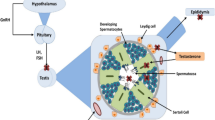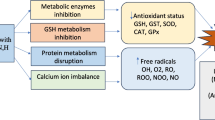Abstract
Management of fluoride (F) driven abnormalities is a great challenge. The present study emphasized on the abrogation of F facilitated uterine dysfunction by vitamin C and E. In the present investigation Wistar rats were fed with 200 ppm NaF at the dose of 10 mg/kg body weight orally for 28 days along with co-treatment with vitamin C and E at the doses of 50 mg/kg body weight and 15 mg/kg body weight, respectively. F treated group presented a concomitant decrease in the activity of uterine superoxide dismutase (SOD) and catalase (CAT). F ingestion developed up-regulation of tumor necrosis factor (TNF-α) and nuclear factor κB (NF-κB). The pro-apoptotic genes Bax and p53 expressions in uterine tissue were raised in response to fluoridation followed by suppression of anti-apoptotic gene Bcl-2. Vitamin C and E employed its constructive action against F intoxication by weakening TNF-α and NF-κB followed by a promotion of Bcl-2 expression along with Bax and p53 suppression. However, present investigation established the anti-oxidative, anti-inflammatory and anti-apoptotic events of Vitamin C and E.





Similar content being viewed by others
References
Akturk, O., H. Demirin, R. Sutcu, N. Yilmaz, H. Koylu, and I. Altuntas. 2006. The effects of diazinon on lipid peroxidation and antioxidant enzymes in rat heart and ameliorating role of vitamin E and vitamin C. Cell Biology and Toxicology 22 (6): 455–461.
AlEnazi, M.M. 2007. Influence of alpha tocopherol on heat stress-induced changes in the reproductive function of Swiss albino mice. Saudi Journal of Biological Sciences 14 (1): 61–67.
Al-Hiyasat, A.S., A.M. Elbetieha, and H. Darmani. 2000. Reproductive toxic effects of ingestion of sodium fluoride in female rats. Fluoride 33 (2): 79–84.
Almeida, O.F.X., G.L. Conde, C. Crochemore, B.A. Demeneix, D. Fischer, A.H.S. Hassan, M. Meyer, F. Holsboer, and T.M. Michaelidis. 2000. Subtle shifts in the ratio between pro-and antiapoptotic molecules after activation of corticosteroid receptors decide neuronal fate. The FASEB Journal 14 (5): 779–790.
Basu, T.K., and J.W. Dickerson. 1996. Vitamin C. In Vitamins in human health and diseases, 125–147. Wallingford: CAD International.
Beharka, A.A., D. Wu, M. Serafini, and S.N. Meydani. 2002. Mechanism of vitamin E inhibition of cyclooxygenase activity in macrophages from old mice: role of peroxynitrite. Free Radical Biology and Medicine 32 (6): 503–511.
Bowie, A.G., and L.A. O’Neill. 2000. Vitamin C inhibits NF-κB activation by TNF via the activation of p38 mitogen-activated protein kinase. The Journal of Immunology 165 (12): 7180–7188.
Brandt, R.B., J.E. Laux, S.E. Spainhour, and E.S. Kline. 1987. Lactate dehydrogenase in rat mitochondria. Archives of Biochemistry and Biophysics 259 (2): 412–422.
Chan, A.C. 1993. Partners in defense, vitamin E and vitamin C. Canadian Journal of Physiology and Pharmacology 71 (9): 725–731.
Chauhan, S.S., P. Celi, E.N. Ponnampalam, B.J. Leury, F. Liu, and F.R. Dunshea. 2014. Antioxidant dynamics in the live animal and implications for ruminant health and product (meat/milk) quality: role of vitamin E and selenium. Animal Production Science 54 (10): 1525–1536.
Chen, L., H. Chen, C. Yao, C. Chang, H. Xia, C. Zhang, Y. Zhou, Q. Yao, and K. Chen. 2015. The toxicity of NaF on BmN cells and a comparative proteomics approach to identify protein expression changes in cells under NaF-stress: impact of NaF on BmN cells. Journal of Hazardous Materials 286: 624–631.
Chinoy, N.J., and A. Sharma. 1998. Amelioration of fluoride toxicity by vitamins E and D in reproductive functions of male mice. Fluoride 31 (4): 203–216.
Choubisa, S.L. 2012. Status of fluorosis in animals. Proceedings of the National Academy of Sciences, India Section B: Biological Sciences 82 (3): 331–339.
Dhurvey, V., and M. Thakare. 2016. The effect of sodium fluoride intoxication on the estrous cycle and ovarian hormones in rats. Fluoride 49 (3): 223–232.
Fischer-Nielsen, A., S. Loft, and K.G. Jensen. 1993. Effect of ascorbate and 5-aminosalicylic acid on light-induced 8-hydroxydeoxyguanosine formation in V79 Chinese hamster cells. Carcinogenesis 14 (11): 2431–2433.
Ghosh, D., S. Das, R. Maiti, D. Jana, and U.B. Das. 2002. Testicular toxicity in sodium fluoride treated rats: association with oxidative stress. Reproductive Toxicology 16 (4): 385–390.
Gukovsky, I., and A. Gukovskaya. 2013. Nuclear factor-κB in pancreatitis: Jack-of-all-trades, but which one is more important? Gastroenterology 144 (1): 26–29.
Guney, M., B. Oral, H. Demirin, N. Karahan, T. Mungan, and N. Delibas. 2007. Protective effects of vitamins C and E against endometrial damage and oxidative stress in fluoride intoxication. Clinical and Experimental Pharmacology and Physiology 34 (5–6): 467–474.
Hadwan, M.H. 2018. Simple spectrophotometric assay for measuring catalase activity in biological tissues. BMC Biochemistry 19 (1): 1–8.
Haendeler, J., A.M. Zeiher, and S. Dimmeler. 1996. Vitamin C and E prevent lipopolysaccharide-induced apoptosis in human endothelial cells by modulation of Bcl-2 and Bax. European Journal of Pharmacology 317 (2–3): 407–411.
He, L.F., and J.G. Chen. 2006. DNA damage, apoptosis and cell cycle changes induced by fluoride in rat oral mucosal cells and hepatocytes. World Journal of Gastroenterology: WJG 12 (7): 1144–1148.
Hordyjewska, A., and K. Pasternak. 2004. Influence of fluoride on organism of human. J Elementol 9 (4): 883–887.
Jana, L., P.P. Maity, H. Perveen, M. Dash, S. Jana, A. Dey, S.K. De, and S. Chattopadhyay. 2018. Attenuation of utero-toxicity, metabolic dysfunction and inflammation by soy protein concentrate in rats exposed to fluoridated water: consequence of hyperlipidemia in parallel with hypohomocysteinemia. Environmental Science and Pollution Research 25 (36): 36462–36473.
Jurczuk, M., M.M. Brzóska, and J. Moniuszko-Jakoniuk. 2007. Hepatic and renal concentrations of vitamins E and C in lead-and ethanol-exposed rats. An assessment of their involvement in the mechanisms of peroxidative damage. Food and Chemical Toxicology 45 (8): 1478–1486.
Kang, J.H., S.I. Yun, M.H. Park, J.H. Park, S.Y. Jeong, and H.O. Park. 2013. Anti-obesity effect of Lactobacillus gasseri BNR17 in high-sucrose diet-induced obese mice. PLoS ONE 8 (1): 1–8.
Luperchio, S., S. Tamir, and S.R. Tannenbaum. 1996. NO-induced oxidative stress and glutathione metabolism in rodent and human cells. Free Radical Biology and Medicine 21 (4): 513–519.
Lutsenko, E.A., J.M. Cárcamo, and D.W. Golde. 2002. Vitamin C prevents DNA mutation induced by oxidative stress. Journal of Biological Chemistry 277 (19): 16895–16899.
Mikirova, N., and R.C. Scimeca. 2016. Gene expression response to ascorbic acid in mice implanted with sarcoma S180 cells. Journal of Translational Science 2 (3): 145–153.
Moemeni, H., M. Moallem, H. Parsian, S.R. Hosseini, H. Noreddini, A. Mosapour, H. Negahdar, M. Alizadeh, and Z.S. Kelagari. 2018. A comparison of serum lead status among elderly osteopaenic patients, elderly osteoporotic patients and healthy controls. West Indian Medical Journal 67 (3): 248–253.
Murray, A.A., M.D. Molinek, S.J. Baker, F.N. Kojima, M.F. Smith, S. Hillier, and N. Spears. 2001. Role of ascorbic acid in promoting follicle integrity and survival in intact mouse ovarian follicles in vitro. Reproduction-Cambridge 121 (1): 89–96.
Pattichis, K., L.L. Louca, and V. Glover. 1994. Quantitation of soluble superoxide dismutase in rat striata, based on the inhibition of nitrite formation from hydroxylammonium chloride. Analytical Biochemistry 221 (2): 428–431.
Reddy, K.S., N.V. Reddy, P. Niharika, M.A. Reddy, H. Reddy, and V. Daneswari. 2017. Defluoridation of water using natural adsorbents. International Journal of Pedodontic Rehabilitation 2 (2): 51–54.
Sharma, J.D., M. Solanki, and D. Solanki. 2007. Sodium fluoride toxicity on reproductive organs of female albino rats. Asian Journal of Experimental Biological Sciences 21 (2): 359–364.
Singh, N.P., M.T. McCoy, R.R. Tice, and E.L. Schneider. 1988. A simple technique for quantitation of low levels of DNA damage in individual cells. Experimental Cell Research 175 (1): 184–191.
Subramaniam, S., S. Shyama, and D.C. Shyamala. 1994. Protective effect of vitamin E against CMF–induced damages in Small intestinal brush border membrane of rats. Indian Journal of Pharmacology 26 (3): 213.
Tan, S., B. Gao, Y. Tao, J. Guo, and Z.Q. Su. 2014. Antiobese effects of capsaicin–chitosan microsphere (CCMS) in obese rats induced by high fat diet. Journal of Agricultural and Food Chemistry 62 (8): 1866–1874.
Tian, Y., M. Huo, G. Li, Y. Li, and J. Wang. 2016. Regulation of LPS-induced mRNA expression of pro-inflammatory cytokines via alteration of NF-κB activity in mouse peritoneal macrophages exposed to fluoride. Chemosphere 161: 89–95.
Tu, W., Qian, Z., Yin, L., Lianyong, H., Qin, W., Panpan, C., Shun, Z., Aiguo, W., Xue, Z. 2018. Fluoride induces apoptosis via inhibiting SIRT1 activity to activate mitochondrial p53 pathway in human neuroblastoma SH-SY5Y cells. Toxicology and Applied Pharmacology 347: 60–69.
Udenfriend, S., C.T. Clark, J. Axelrod, and B.B. Brodie. 1954. Ascorbic acid in aromatic hydroxylation. Journal of Biological Chemistry 208: 731–738.
Wang, A.G., T. Xia, Q.L. Chu, M. Zhang, F. Liu, X.M. Chen, and K.D. Yang. 2004. Effects of fluoride on lipid peroxidation, DNA damage and apoptosis in human embryo hepatocytes. Biomedical and Environmental Sciences: BES 17 (2): 217–222.
Weydert, C.J., and J.J. Cullen. 2010. Measurement of superoxide dismutase, catalase and glutathione peroxidase in cultured cells and tissue. Nature Protocols 5 (1): 51–66.
World Health Organization & International Programme on Chemical Safety. 2010. The WHO recommended classification of pesticides by hazard and guidelines to classification 2009. World Health Organization.
Zhang, Z.Y., G.Z. Zhang, X.J. Liu, G.F. Sun, and J.K. Guan. 1993. Effects of organic fluoride exposure on the development their offspring. Fluoride 26 (5): 223–224.
Zhang, D., S. Okada, Y. Yu, P. Zheng, R. Yamaguchi, and H. Kasai. 1997. Vitamin E inhibits apoptosis, DNA modification, and cancer incidence induced by iron-mediated peroxidation in Wistar rat kidney. Cancer Research 57 (12): 2410–2414.
Zhou, Y., H. Zhang, J. He, X. Chen, Y. Ding, Y. Wang, and X. Liu. 2013. Effects of sodium fluoride on reproductive function in female rats. Food and Chemical Toxicology 56: 297–303.
Author information
Authors and Affiliations
Corresponding author
Additional information
Publisher's Note
Springer Nature remains neutral with regard to jurisdictional claims in published maps and institutional affiliations.
Rights and permissions
About this article
Cite this article
Maity, P.P., Dash, M., Dey, A. et al. Vitamin C and E in Fluoride Induced Uterine Oxidative Stress and Apoptotic Gene Expression in Wistar Rats. Proc Zool Soc 74, 189–197 (2021). https://doi.org/10.1007/s12595-021-00362-w
Received:
Revised:
Accepted:
Published:
Issue Date:
DOI: https://doi.org/10.1007/s12595-021-00362-w




